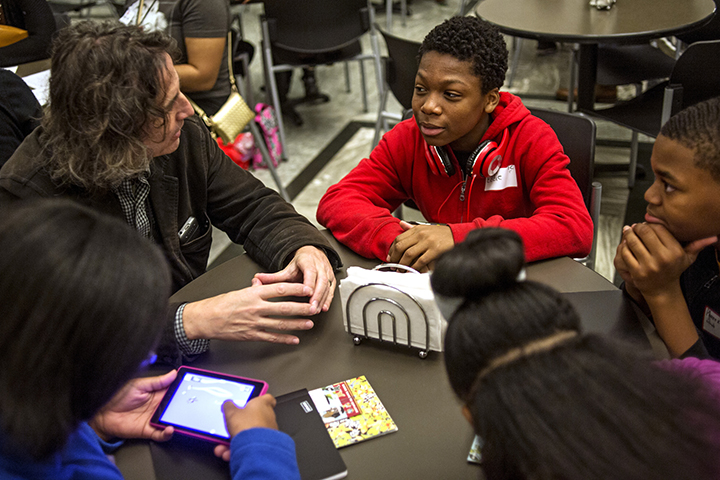Ink runs from the corners of my mouth.
—Mark Strand, “Eating Poetry”
There is no happiness like mine.
I have been eating poetry.
I know about that happiness. There are days when the ink runs from the corners of my mouth and I can cry out, as Strand does at the end of his poem, “I am a new man.”
But there are days when I’d rather watch others eat, when I like to stand back and watch that ink run down from the lips of the Detroit Public School children that I teach through my work as a poet-in-the-schools with the InsideOut Literary Arts Project.
I have taught “Eating Poetry” to such ink-lipped children: children who have been dogged and belittled for not measuring up, for underachieving, for failing in the mechanical eyes of standardized measures of intelligence.
None of the children I teach are failures. It’s true that many of them live beneath the poverty level, that most of them are eligible to receive free breakfast and lunch, that many of them come from broken homes and drag with them to school the stresses that come from growing up poor and sometimes hungry.
There are places for kids to go, for their parents to take them, if they are hungry: food banks, community centers, etc. But the hunger I want to feed leaves not just the belly empty, but the soul, the spirit.
I often tell my students, “Poetry is good food.” I am leaning, of course, on the Campbell’s Soup claim that soup is good food, which it is. But the language of poetry is its own kind of sweet, medicinal broth.
For seven years I worked as the writer-in-residence at Golightly Education Center in Detroit. Here I had the pleasure and privilege to work with many students year after year—some from when they were second-graders still struggling to hold a pencil up until they were seventh-graders, whose bigger problems involved issues such as drugs and broken hearts. After a few years of weekly doses of reading and writing and eating poetry, my job was easy. I’d walk into the school with new twists on old recipes for soup: Merwin’s Meatball Minestrone, Bishop’s Black Bean, Levine and Lorca’s Duende Lentil Combo. The kids ate it up. And the memory of the meals lasts in the way that sensory experiences always do: they last through the promise of their own renewal.
Poetry lives, I believe, in the heart of every child. But this falls short of saying what I’m trying to say and is said best through the poem of the child.
Hear the child.
“Poetry Lives”
by Troinana BarnettPoetry lives
in the strings
of a guitar,
the peak
of a mountain.Poetry lives
in the sass
of a girl’s walk,
the wishes
of a dying child.Poetry lives
in the stretch
of an eyelash,
the flash of
a blinding light.Poetry lives
in every rhyme
every melody
we speak,
every line
every stanza
we write.
Poetry lives and poetry lives on and lasts because poetry offers students a non-linear path into its woods. Its difference—the way it looks on the page, the sounds of words carefully chosen, the musicality of its broken lines—is what draws a child inside. Children are naturally curious creatures. They learn the world by doing their best to grab at it and put it into their mouths. The same can be said for how children take an almost organic liking to poetry, as long as it is offered up without restriction, without a belief that poems only mean one thing.
When confronted with the question, “What is a poem?” young marvel Eddie Stewart understands the multitudes that a poem can contain.
“What Is a Poem?”
by Eddie StewartA poem is a ball of fire
lifting into the sky.No. A poem is a girl with hair
long enough to climb.A poem is a car speeding down the road
going past the speed limit.A poem is a flower blooming
faster than all the other flowers.No. A poem is a lesson that you will
always remember.A poem is a mother bird
teaching her babies how to fly.A poem is the happiest mother in the world
on Mother’s Day.No. A poem is a man riding a dragon saying
“This is the best day of my life.”Hey, don’t you know that you can rise up
to become whatever you want.Did you know the world is a better
place with you on it.I’m Eddie Stewart and I want everyone
to get off their feet and be as happy as you can be.Everyone, I want you to share some
happy times in your life with friends.Don’t be afraid, you can make a bigger difference.
Remember: you are a Queen bee watching over the hive.
I like to make sure that the poems are tangible objects, so I begin by passing out copies of the day’s model poem to each student, so that they can hold the poem’s words in their hands. Then I like to read the poem out loud, so that its cadence can cleanly enter their ears. Then it’s time to put the poem into their mouths, so I invite students to take turns reading a line, a stanza, sometimes an entire poem, so that their tongues can taste it. We do this for as long as there are mouths wanting to open, to speak the poem into being.
I like Gertrude Stein’s claim that “Children themselves are poetry.” Poems, like children, live. Poets, like parents, live through their poems. When I asked students recently what they like most about poetry, what many of them said was, “In a poem, there is no right or wrong. The poem is what it is.”
To see children the way children see poetry: the way a child is what a child is. Like a poem is, yes? Where much is possible. No right or wrong, though as Eddie Stewart tells us, “A poem is a lesson that you will/ always remember.” And like a poem is, a child is there for us to listen to, to lean closer towards, to learn from.
If you’re in the mood to read or even write some poetry, you could check out the amateur poetry chart on The Talent Bank website. Whatever your favorite genre, there’s plenty of poems to peruse from up and coming writers.
Photo (top) of Peter Markus with Eddie Stewart by Erin Kirkland
Peter Markus is the senior writer with InsideOut Literary Arts Project of Detroit, where he has worked as a writer in the public schools for the past 20 years. In those 20 years, he has also published six books of fiction, the most recent of which is The Fish and the Not Fish. He also edited, with InsideOut founder Terry Blackhawk, To Light a Fire: 20 Years with the InsideOut Literary Arts Project, published in 2015 by Wayne State University Press.



